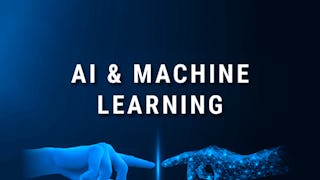Use statistical learning techniques like linear regression and classification to solve common machine learning problems. Complete short coding assignments in Python.

Enjoy unlimited growth with a year of Coursera Plus for $199 (regularly $399). Save now.

Machine Learning Essentials
This course is part of AI and Machine Learning Essentials with Python Specialization


Instructors: Chris Callison-Burch
Included with
Recommended experience
What you'll learn
Review probability basics and understand essential theoretical framework to analyze statistical learning problems.
Use linear regression and Python programming to solve machine learning problems.
Skills you'll gain
- Data Science
- Machine Learning
- Dimensionality Reduction
- Statistical Analysis
- Python Programming
- Classification Algorithms
- Model Evaluation
- Logistic Regression
- Statistical Hypothesis Testing
- Machine Learning Methods
- Statistical Machine Learning
- Applied Machine Learning
- Regression Analysis
- Feature Engineering
- Supervised Learning
- Statistical Methods
- Probability & Statistics
Details to know

Add to your LinkedIn profile
12 assignments
See how employees at top companies are mastering in-demand skills

Build your subject-matter expertise
- Learn new concepts from industry experts
- Gain a foundational understanding of a subject or tool
- Develop job-relevant skills with hands-on projects
- Earn a shareable career certificate

There are 4 modules in this course
This module introduces the standard theoretical framework used to analyze statistical learning problems. We start by covering the concept of regression function and the need for parametric models to estimate it due to the curse of dimensionality. We continue by presenting tools to assess the quality of a parametric model and discuss the bias-variance tradeoff as a theoretical framework to understand overfitting and optimal model flexibility.
What's included
8 videos1 reading3 assignments1 programming assignment
In this module, we cover the problem of linear regression. We start with a formal statement of the problem, we derive a solution as an optimization problem, and provide a closed-form expression using the matrix pseudoinverse. We then move on to analyze the statistical properties of the linear regression coefficients, such as their covariance and variances. We use this statistical analysis to determine coefficient accuracy and analyze confidence intervals. We then move on to the topic of hypothesis testing, which we use to determine dependencies between input variables and outputs. We finalize with a collection of metrics to measure model accuracy, and continue with the introduction to the Python programming language. Please note, there is no formal assignment this week, and we hope that everyone participates in the discussion instead.
What's included
7 videos3 assignments1 discussion prompt
In this module, you will learn how to include categorical (discrete) inputs in your linear regression problem, as well as nonlinear effects, such as polynomial and interaction terms. As a companion to this theoretical content, there are two recitation videos that demonstrate how to solve linear regression problems in Python. You will need to use this knowledge to complete a programming project.
What's included
7 videos3 assignments1 programming assignment
In this module, we introduce classification problems from the lens of statistical learning. We start by introducing a generative model based on the concept of conditional class probability. Using these probabilities, we show how to build the Bayes optimal classifier which minimizes the expected misclassification error. We then move on to present logistic regression, in conjunction with maximum likelihood estimation, for parametric estimation of the conditional class probabilities from data. We also extend the idea of hypothesis testing to the context of logistic regression.
What's included
7 videos1 reading3 assignments1 programming assignment
Earn a career certificate
Add this credential to your LinkedIn profile, resume, or CV. Share it on social media and in your performance review.
Offered by
Explore more from Machine Learning
 Status: Free
Status: FreeAmazon Web Services
 Status: Free Trial
Status: Free Trial Status: Free TrialStatus: AI skills
Status: Free TrialStatus: AI skillsUniversity of Pennsylvania
 Status: Preview
Status: PreviewO.P. Jindal Global University
Why people choose Coursera for their career





Open new doors with Coursera Plus
Unlimited access to 10,000+ world-class courses, hands-on projects, and job-ready certificate programs - all included in your subscription
Advance your career with an online degree
Earn a degree from world-class universities - 100% online
Join over 3,400 global companies that choose Coursera for Business
Upskill your employees to excel in the digital economy
Frequently asked questions
To access the course materials, assignments and to earn a Certificate, you will need to purchase the Certificate experience when you enroll in a course. You can try a Free Trial instead, or apply for Financial Aid. The course may offer 'Full Course, No Certificate' instead. This option lets you see all course materials, submit required assessments, and get a final grade. This also means that you will not be able to purchase a Certificate experience.
When you enroll in the course, you get access to all of the courses in the Specialization, and you earn a certificate when you complete the work. Your electronic Certificate will be added to your Accomplishments page - from there, you can print your Certificate or add it to your LinkedIn profile.
Yes. In select learning programs, you can apply for financial aid or a scholarship if you can’t afford the enrollment fee. If fin aid or scholarship is available for your learning program selection, you’ll find a link to apply on the description page.
More questions
Financial aid available,

